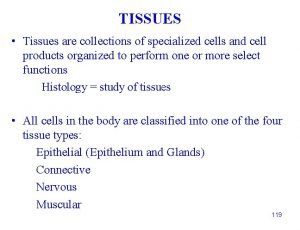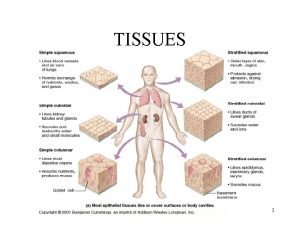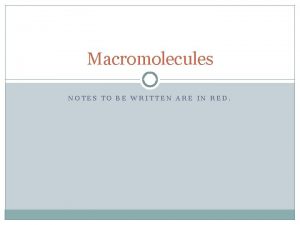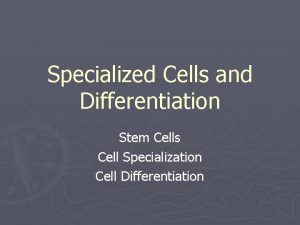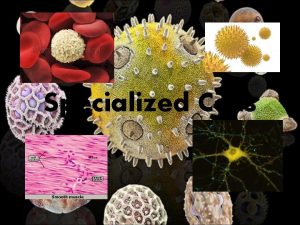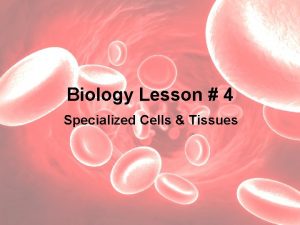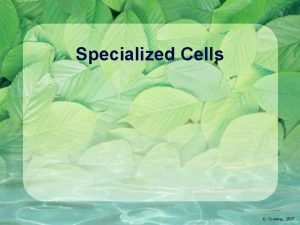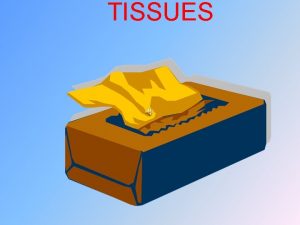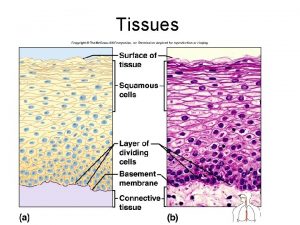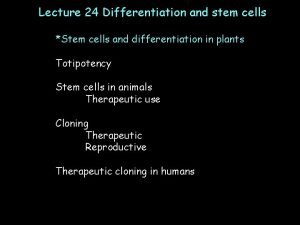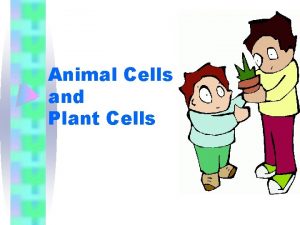Animal Cell Differentiation STEM CELLS SPECIALIZED CELLS TISSUES















- Slides: 15

Animal Cell Differentiation STEM CELLS SPECIALIZED CELLS TISSUES

Hierarchy of Organization

Organ Systems Groups of organs that work together to perform a major body function There are 11 major organ systems in humans Plus: Reproductive System Immune System Urinary System Digestive System Respiratory System

Organs Bodily structures that are made of specific types of tissues and perform one or more specific biological functions Digestive System Organs Respiratory System Organs

Tissues • Specialization and organization of cells lead to the formation of tissues • A tissue consists of a few types of closely associated cells that have specific functions • There are 4 main types of tissues

Epithelial Tissue • Description: Cells pack tightly together forming a continuous layer (a sheet) that covers body surfaces or lines a cavity within the body Examples: • Outer layer of skin • Linings of digestive and respiratory tracts • Function: • Protection (e. g. , layer of the skin) • Absorption (e. g. , layer that lines the intestines absorb glucose) • Secretion (e. g. , layer of glands that secrete hormones) Epithelial cells of the stomach lining

Connective Tissue • Description: Binds together and supports the other structures of the body • Functions: • Protection of underlying organs • Storage of materials • Transport of materials 6 Example Types of Connective Tissue

Muscle Tissue • Description: bundles of long cells called muscle fibers contain proteins that contracts and shorten • Function: permit movement Examples

Nervous Tissue • Description: long, thin cells with branches at ends that are capable of conducting electrical impulses • Function: Receives stimuli (external information) and transmit information in the form of nerve impulses. Controls the action of glands and muscles • Examples: Brain, spinal cord and bundles of nerve cells (neurons) supporting cells called glial cells

How do cells develop differently? • All multicellular organisms start as a single cell • Through mitotic divisions the single cell will become a cluster of many cells

Stem Cells • Stem cells are cells that can differentiate into many different types of cells (and tissues) • Stem cells divide by mitosis • The type of cell that the stem cell becomes is determined by signals from DNA

Types of Stem Cells • Totipotent Cells • Zygote • Pluripotent Cells • Embryonic stem cells • Can become any kind of cell • Multipotent Cells • Adult stem cells • Pre-programmed to become a certain type of cell • Specialized Cells • Specific function


Stem Cell Uses • Adult Stem Cell Therapy – bone marrow transplants to treat leukemia • Embryonic Cell Therapy – future cures for cancer, Parkinson’s disease, spinal cord injuries? • Why is this topic controversial? http: //learn. genetics. utah. edu/content/tech/stemcells/

Stem Cell Research in Canada • Canada is an international leader in embryonic stem cell research • Principles based on ethical guidelines include: • Research undertaken should have potential health benefits for Canadians; • Free and informed consent, provided voluntarily and with full disclosure of all information relevant to the consent; • Respect for privacy and confidentiality; • No direct or indirect payment for tissues collected for stem cell research and no financial incentives; • No creation of embryos for research purposes; • Respect individual and community notions of human dignity and physical, spiritual and cultural integrity
 Body tissues chapter 3 cells and tissues
Body tissues chapter 3 cells and tissues Body tissues worksheet
Body tissues worksheet Body tissues chapter 3 cells and tissues
Body tissues chapter 3 cells and tissues Cells form tissues. tissues form __________.
Cells form tissues. tissues form __________. Body tissues chapter 3 cells and tissues
Body tissues chapter 3 cells and tissues Collections of specialized cells and cell products
Collections of specialized cells and cell products Connective tissue specialized
Connective tissue specialized Venn diagram for plant and animal cells
Venn diagram for plant and animal cells Tissues are groups of similar cells working together to
Tissues are groups of similar cells working together to Tissues are groups of similar cells working together to
Tissues are groups of similar cells working together to Cells-tissues-organ-systems-organism
Cells-tissues-organ-systems-organism Chapter 3 cells and tissues figure 3-7
Chapter 3 cells and tissues figure 3-7 Chapter 3 cells and tissues figure 3-1
Chapter 3 cells and tissues figure 3-1 Chapter 3 cells and tissues figure 3-1
Chapter 3 cells and tissues figure 3-1 Tissues are groups of similar cells working together to:
Tissues are groups of similar cells working together to: What macromolecule is a prominent part of animal tissues
What macromolecule is a prominent part of animal tissues





